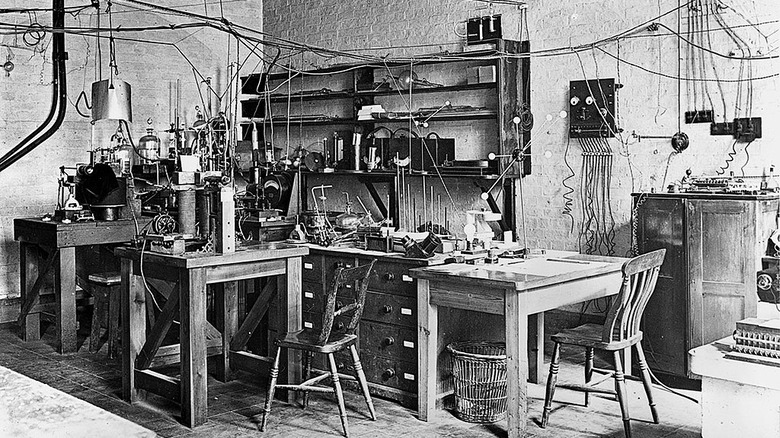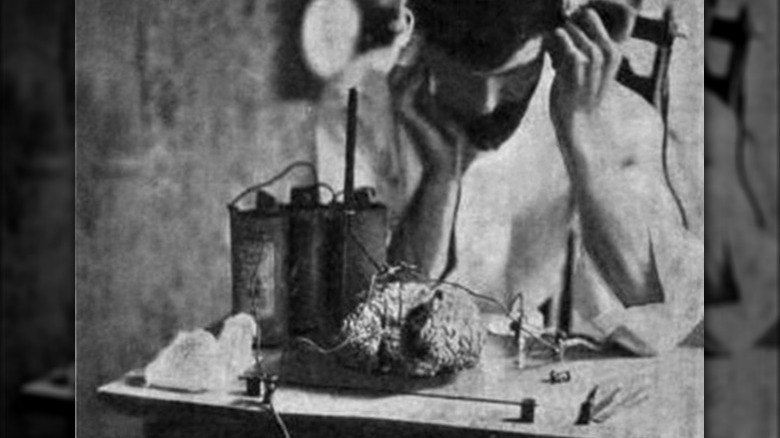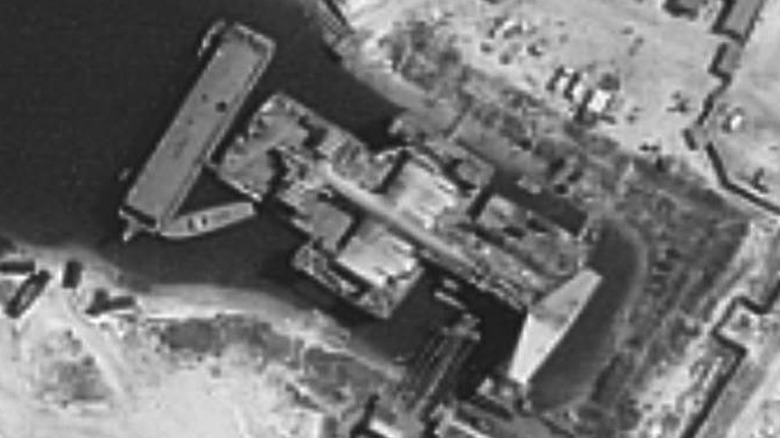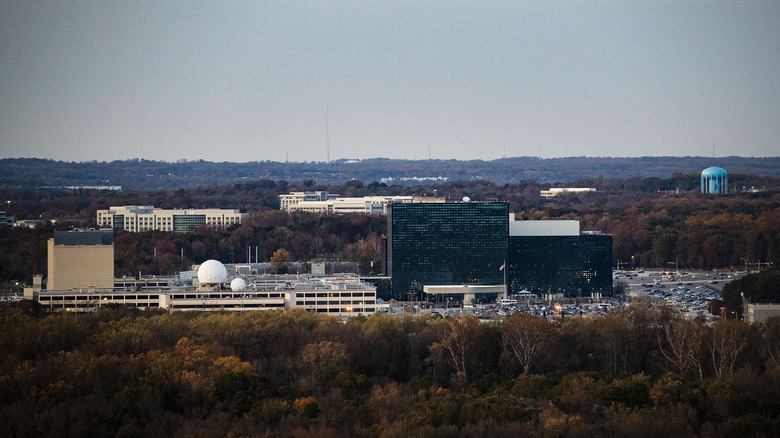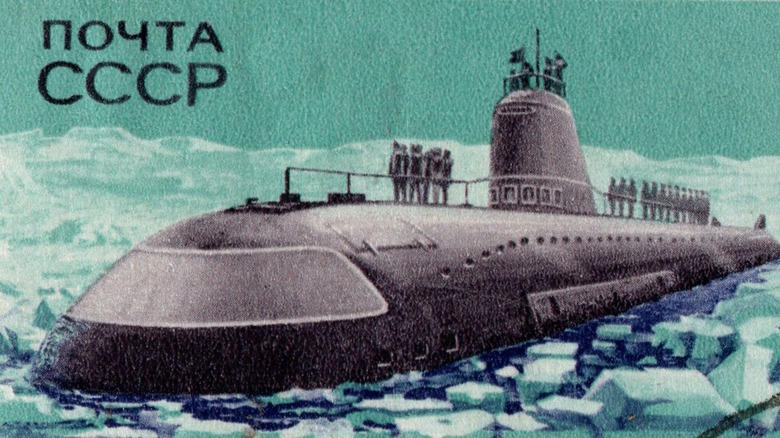The Untold Truth Of Psychic Spies
Let's be honest, the idea of psychic spies sounds like something straight out of a bad sci-fi movie. Superpowered spies seem like the kind of thing that Hollywood would gladly cook up to try and cash in on the public's fascination with the paranormal (not to mention the box office success of superhero movies as of the 2010s). And, funnily enough, it's actually something that Hollywood has already done; psychic spies are the main focus of the 2009 film "The Men Who Stare at Goats."
But, here's the thing. That movie, as ridiculous as its premise might sound, isn't quite as nonsensical as it initially seems. In actuality, the film does have some basis in real life events – namely, it's pulling from very real Cold War era efforts by both the United States and the Soviet Union to weaponize psychic powers. And that's no joke.
The Cold War was truly the time for some absolutely bizarre (and occasionally disturbing) experiments, but even with that in mind, the research done on psychic powers might top the list for being the strangest.
Psychic research in the pre-Cold War era
Even though this whole "psychic spies" interest sprung up heavily as a result of Cold War era tensions, that didn't mean that the late 20th century originated psychic research. After all, psychics – even those clearly revealed to be frauds – have captured the imagination of the public throughout history and well into the modern day, per The Conversation, and an article published in Strategic Analysis adds that the term "Extra Sensory Perception" (ESP) was actually coined by a parapsychology researcher back in 1934.
That said, Soviet research into the paranormal stretches back even further. "Unconventional research in USSR and Russia: short overview" explains it goes back as early as the 1890s when an official commission was put together to determine the validity of mind reading and "mental suggestion." Though the questions stemmed from spiritualism and myth, by 1917, researchers began hypothesizing that the brain could actually output radiation that functioned a bit like radio waves. The questions became far more scientific as time passed, and in the decades leading up to World War II, full laboratories were opened with the intention of figuring out the possible science behind the paranormal.
The Soviets were searching for psychic particles
Although both the U.S. and the Soviet Union were both looking into ways to weaponize psychic powers, it's worth saying that they didn't go about that research in exactly the same ways. Compared to the Americans, Soviet research was arguably more scientific – and biological, in particular (though the whole question of where psychic powers and science cross over is a whole different discussion).
According to the New York Times, Soviet research focused on supposed "psi particles," described as the "physical basis for psychic energy." And older research – documented in "Unconventional research in USSR and Russia: short overview" – seemed to further imply that these "psi particles" and psychic energy in general actually radiated out from a person capable of exhibiting psychic powers.
The set-up for a particular experiment from the 1930s honestly resembled something you'd expect out of a normal physics lab: a lead box at one end of a pipe and holding a source of radiation, and a sensor at the other end of that same pipe. Except that the radiation source was a psychic (or hypnotist) and the sensor was another human being. Long story short: the experiment apparently showed that this psychic energy behaved similarly to any other source of electromagnetic radiation (such as light), diffracting and responding to mirrors that were added into the picture. It even had its own particular wavelength – about 2 millimeters.
Nina Kulagina: the woman who started the psychic arms race
While the ideas of psychics and psychic powers have been around for a while, there was a particular catalyst to start fighting on the latest battlefield of the Cold War: the psychic arms race. And that particular catalyst? Nina Kulagina.
Looking into Kulagina's background doesn't raise a single red flag – according to Timeline, she'd been working simply as a housewife, then as a member of the Red Army. Nothing all too bizarre, all things considered. But by the 1960s, she'd caught the eye of Soviet scientists, who wanted to test her psychic abilities. And that led to a number of very, very interesting videos of her supposed telekinetic powers. According to Encyclopedia.com, she was seen being able to move small objects with her mind – pens, matchsticks, cigarettes, and the like. She was even shown to be able to move a compass needle just by placing her hand above it.
The most disturbing, though? Supposedly, she was able to literally stop a frog's heart from beating. The organ in question was kept beating in a special solution, and after 20 minutes of preparation, Kulagina's own heart rate increased dramatically, right around the same time that the frog heart suddenly went still. A Soviet scientist who didn't believe in her powers was her next subject; both were hooked up to an EKG, and in no time at all, the researcher's heart rate had increased to "dangerous" levels, leading to the termination of the experiment. Those videos shortly made it overseas to the U.S., and government officials wondered just what war they would have to prepare for.
Soviet experiments were pretty gruesome
As with many messed-up things from the Cold War era, this search for psychic spies went to some pretty dark places, and records of Soviet experiments dedicated to this stuff aren't pretty.
To start off (relatively) lightly, there was quite a bit of animal testing. According to The Guardian, a female rabbit had electrodes planted in her brain while her litter was taken below the sea in a submarine. The young rabbits were systematically killed, and researchers wanted to know if the mother's brain would react, pointing to a telepathic connection. (It did, oddly enough.) Per "Unconventional research in USSR and Russia: short overview," sticking electrodes in rabbit brains was apparently a theme, as other pairs of rabbits were also used as rudimentary communication devices. One rabbit would receive an approximately 2-volt stimulant, and its partner would apparently react to that.
But for the darker stuff? There was something of a fascination with electromagnetic fields, and whether those fields could be used to fundamentally alter biology (basically the stuff of every superhero origin story). If you just shot someone with electromagnetic radiation, how would it change their body and, more importantly, their mind? Actually finding this out sounds horribly unethical ... but this was the Cold War. Based on the vague claim that animals stuck in magnetic fields could see through walls, Soviet inmates were subjected to those same "pulsing magnetic fields" (via The Guardian) in the hopes they would somehow become psychic. The results? Quite a bit of death.
Project Star Gate
With the introduction of potential psychic weapons, the U.S. was determined not to fall behind in this new arms race, and in order to ensure their dominance in the field, a new program was instituted: Project Star Gate. As told by the Independent, Project Star Gate was largely associated with the CIA, though a handful of other organizations were also involved, including the Stanford Research Institute, the U.S. Navy (via The New York Times), the Defense Intelligence Agency (DIA), and even the Pentagon (via The Washington Post).
Its exact goals are sort of hard to pin down, though the project generally encompassed all of the weird psychic and paranormal interests of the U.S. government from 1978 until 1995. It was intended to look into all realms of the paranormal – telepathy, telekinesis, ESP, and clairvoyance – for which there was "no known defense" (via The Independent). And, as an extra plus, psychic warfare seemed like it could be both "passive" and "inexpensive" (though the millions of dollars of government funding seems to prove the latter point wrong).
The U.S. was focused on remote viewing
The idea of weaponizing psychics and using them as spies is actually a bit more multifaceted than it initially might sound. The New York Times lists multiple different types of psychic research, but when it came to the research that the U.S. was interested in, well, there was a definite preference: ESP, and particularly the idea of "remote viewing" (via the New York Times). A psychic might be asked to describe the details of a location thousands of miles away, despite the location itself being relatively unknown to said psychic.
And, as ridiculous as it might sound, there seemed to be some level of success. According to an article in the journal Strategic Analysis, there were quite a few of these remote viewing sessions. In one instance, Pat Price was able to describe an ex-Soviet underground nuclear facility, which the CIA already possessed spy photos of; Price managed to describe the cranes and gas cylinders to a degree of accuracy that researchers claimed they "would never have believed" had they not seen it for themselves.
But even stranger? Joe McMoneagle was told to view a waterside construction site which the National Security Council was concerned about. He described the building of a submarine (the dimensions he gave would make it larger than any the U.S. had), even predicting that it would be launched four months later. It seemed impossible – no one had heard of such a project – and yet, his prediction shortly proved to be entirely accurate. Another psychic even did a remote viewing of Jupiter, describing the planet with rings – an apparent mistake at the time ... at least until a NASA mission confirmed otherwise.
A group of psychics were kept at Fort Meade
A number of the psychic experiments conducted by the U.S. were, overall, fairly low-stakes kinds of deals. It made some amount of sense; after all, even with some successes, the idea of trusting the outcome of the Cold War to a practice that's largely considered paranormal seems a bit risky. But they were willing to make some exceptions, with the CIA actively keeping a group of psychics on their payroll.
Those psychics were housed at the Fort Meade military base in Maryland and, until the 1990s, were called on regularly to conduct remote viewings (via The Washington Post). The exact nature of those viewings varied quite a bit, though the nature of those missions read as far from low-stakes: figuring out the truth behind a terrorist training facility, locating a rogue customs officer and other fugitives (via CBS), and determining the purpose of a Soviet radar.
That work, at one point, even saw those psychics help the U.S. government navigate a hostage situation. As reported by the Miami Herald, in 1979, the American embassy in Iran was seized by local students who moved to hold a bunch of diplomats hostage. Of course, rescue attempts were launched – and were successful by January 1981 – but in the interim, the Fort Meade psychics were to keep an eye on the hostages and deliver any pertinent information: the hostages' health, guard patterns, changes of location, and the like. They were even directly consulted before an April 1980 rescue attempt (which ultimately ended in a plane crash and general disaster).
Linking psychics with military vehicles
A lot of people have fantasized about having telekinesis and being able to make household objects fly around the room with nothing more than their minds. Well, imagine doing that, but instead of using telekinesis to grab a roll of toilet paper, it could be used to interact with military-grade vehicles.
That was an actual thing that both the U.S. and the Soviet Union wanted to do, although there aren't a whole lot of details to go on. The New York Times mentions that researchers in the late 1950s toyed with the idea of linking a psychic with a submarine, using them as a medium through which undetectable and untraceable messages could be sent. As far as anyone can tell, the project failed and didn't really go anywhere.
And as for the Soviets? They wanted to combine the psychic arms race with the space race – basically, they wanted psychic cosmonauts. A study by the RAND Corporation (via Seeker) explained that psychic cosmonauts could, ideally, "foresee and ... avoid accidents in space" by using precognition. Again, though, the idea didn't really seem to get far off the ground.
No one really knew what was happening
As of the 21st century, there is a bit of information that's been allowed out regarding this research on psychic spies. But at the time, the same couldn't be said, and people couldn't be sure whether any of this was actually real (or a good idea).
Per The New York Times, some members of Congress legitimately pushed for the study of "parapsychology" and psychic powers, believing them to be the next step in modern warfare, likened to the atomic bomb. The same could be said in the Soviet Union (via The New York Times). People on both sides of the Iron Curtain believed this research to be actively pursued, even though both the Pentagon and a KGB-connected scientific writer readily — and vehemently — denied any such claims.
And, of course, there were the skeptics, who thought the whole idea to be ridiculous. Psychic powers are nigh-impossible to validate on a scientific basis, after all, even in the best of conditions, so why would the military even try? Per the Miami Herald, other intelligence agents thought the whole thing was basically a joke, laughing at just the thought that psychics were ever taken seriously.
Were these projects successful?
When you go through the story of these government-approved psychic spies, it's easy to be taken in by all of the sensational bits and the instances where these psychics seemed to be truly dangerous tools wielded by both sides. But, especially considering how deeply this story wades into the paranormal, there are also plenty of reasons to be skeptical.
For one, the projects weren't nearly as successful as they appeared to be on the surface. In the case reported on by the Miami Herald, in which the Fort Meade psychics were to report on the condition of the hostages held in Iran, those reports were rarely correct. If you want the exact numbers, in total, 202 reports were made by the psychics. Over half were "entirely incorrect," and a whole 59 of them had some details that were at least kind of correct (which meant those 59 reports were also kind of incorrect). A grand total of seven were actually accurate. To say those are poor statistics is far from a stretch. The Washington Post only adds to those disappointing stats, noting that, in another experiment, the psychics' predictions were only accurate 5% more often than if they'd been randomly guessing.
So then why is there any sort of sense that these psychics were successful? Well, it might just be a case of bias. CIA officials were essentially grading their own tests, and they would've had reason to make their research look better than it really was. Even if none of their results could ever be replicated (a real red flag when it comes to science).
Uri Geller: television personality ... and psychic spy?
If you've never heard of Uri Geller, here are the basics. A self-proclaimed "psychic superstar" (via BBC), Geller's popularity rose worldwide because of spoons. Well, because he could supposedly bend spoons with his mind. It was a talent he'd apparently begun showing off as a kid, and as he grew older, he expanded his repertoire to include the ability to change the speed of clocks as well as some feats of telepathy. He dazzled world leaders and became something of a pop culture icon, even being featured on the cover of a Marvel comic and making an appearance on "The Tonight Show Starring Johnny Carson."
Although the latter dimmed his star (he couldn't sufficiently recreate his trick on the air), Geller had also caught the eye of the U.S. government, and, per The Guardian, he began working on covert operations for the CIA sometime in the 1970s. Evidently, when he wasn't busy being a celebrity, he took part in an Israeli raid, helped search for Osama bin Laden, and even took on some mysterious responsibilities as a federal agent in Mexico.
His work with government agencies spanned 40 years, and he even displays a framed CIA report, saying he had "demonstrated his paranormal perceptual ability in a convincing and unambiguous manner."
Project MK Ultra and mind control
When it comes to the world of weird Cold War research, there's another aspect to it that sounds pretty odd and very much in the realm of the paranormal. But it's just a bit different than the weaponization of psychic powers. (That said, it's still just as bizarre).
The research in question was Project MK Ultra, which tapped into the possibilities of mind control and, as History calls it, "brain warfare." Word had begun spreading of Communist "brainwashing," American soldiers returning home indoctrinated by the enemy after serving in Korea or the Soviet Union. No one knew just why this was happening, but they suspected advanced psychological warfare.
So the CIA decided to strike back, looking for a way to successfully and reliably affect a person's psyche and actions, whether that was "influenc[ing] people's performance in combat or clandestine operations" or "crush[ing] the human psyche to the point that it would admit anything" (via History Extra). They wanted to fundamentally change people's behavior, and the ways they accomplished this were pretty horrific. Subjects were often vulnerable (poor, mentally ill, etc.) and rarely consented to the experiments, which ranged from electroshock therapy to sexual abuse. And drugs, especially LSD. One of the most infamous of MK Ultra's tests – Operation Midnight Climax – made heavy use of it. Sex workers lured unwitting subjects to a home in San Francisco and dosed them with LSD, all while CIA agents watched from behind a two-way mirror. (The agent in charge later admitted it was a thinly veiled excuse for voyeurism.)

